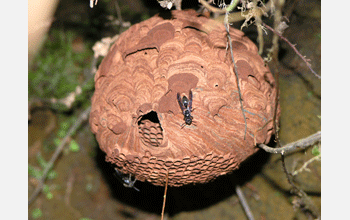Multimedia Gallery
Diversity of Neotropical Social Paper Wasps (Image 15)
The nest paper of this wasp is typically reddish, and has a brittle consistency. In the mountains at Monteverde, Costa Rica, Polybia raui typically nests in road banks and landslides, suspending the nest from small rootlets. (Date of Image: 2007) Image 15 of 19 related images. See Image 16.]
More about this Series
This image was taken as part of a research project by Sean O'Donnell of the University of Washington (principal investigator), and Theresa Jones of the University of Texas-Austin (co-principal investigator). The primary goal of the project was to analyze the relationship of brain development with behavior in social paper wasps (family Vespidae). The results are expected to help researchers understand the neural basis of complex behavior in socially cooperative animals.
The species that were the focus of O'Donnell's and Jones' study are all group-living, social animals, and all have societies that are divided into reproductive queens and helping workers. However, many important features of the wasp's colonies, including colony size and the degree of queen/worker differentiation, vary among species.
O'Donnell and his team focused their analyses on targeted brain regions, especially the mushroom bodies (MB). The MB play a role in several types of learning and memory, and also are important for integrating information from different senses (optical and antennal inputs). The researchers measured the size of key sub-regions of the MB by preserving the head capsules of individually identified wasps with known behavioral histories, and then they took thin sections of their head capsules, including their brains. These sections were stained and then photographed at high magnification. The measurements taken from the photographs enable the researchers to estimate the volumes of particular brain regions, and test whether volume differences correspond to individual differences in behavior.
O'Donnell is also interested in exploring whether brain/behavior relationships have evolved in paper wasps. He is testing whether evolutionary changes in features of social structure, such as colony size and the degree of queen-worker differences, are associated with changes in brain/behavior relationships. Many of the paper wasps pictured in this series--"Diversity of Neotropical Social Paper Wasps"--were collected with the aim of studying the evolution of MB structure and its links to behavior. The wasps in this image series exhibit a wide range of social complexities and nest architecture, and both of these features may be relevant to the evolution of brain architecture--and to brain development.
Social paper wasps in the subfamily Polistinae fall into two broad behavioral categories: Independent-founder and Swarm-founder. The Independent-founders have colonies that are started by a lone queen; they build simple, open-comb nests and typically attain smaller, mature colony sizes of several to several dozen adults. Swarm-founder colonies are started by a coordinated group of queens and workers; they often build more complex nests and achieve larger-sized colonies of hundreds to tens of thousands of adults.
To learn more about Sean O'Donnell's past and current research, visit his website Here.
This research was supported by National Science Foundation grant IBN 03-47315 (Behavioral Neuroscience panel); "Collaborative research: Brain plasticity and division of labor--from simple to complex societies"; lead PI: Sean O'Donnell, University of Washington; co-PI: Theresa Jones, University of Texas-Austin.
Credit: Sean O'Donnell, University of Washington
Images and other media in the National Science Foundation Multimedia Gallery are available for use in print and electronic material by NSF employees, members of the media, university staff, teachers and the general public. All media in the gallery are intended for personal, educational and nonprofit/non-commercial use only.
Images credited to the National Science Foundation, a federal agency, are in the public domain. The images were created by employees of the United States Government as part of their official duties or prepared by contractors as "works for hire" for NSF. You may freely use NSF-credited images and, at your discretion, credit NSF with a "Courtesy: National Science Foundation" notation.
Additional information about general usage can be found in Conditions.
Also Available:
Download the high-resolution JPG version of the image. (5.8 MB)
Use your mouse to right-click (Mac users may need to Ctrl-click) the link above and choose the option that will save the file or target to your computer.

